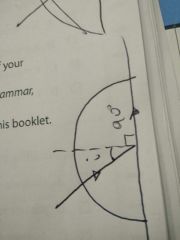![]()
![]()
![]()
Use LEFT and RIGHT arrow keys to navigate between flashcards;
Use UP and DOWN arrow keys to flip the card;
H to show hint;
A reads text to speech;
3 Cards in this Set
- Front
- Back
- 3rd side (hint)
|
What is TIR (total internal reflection) |
This is defined as when the angle of incidence is greater than the critical angle between the two media, so no light is transmitted outside the medium and internally reflected |

|
|
|
What are the problems associated with optical fibres |
1. If there is any scratch on it, the light can escape (because the angle of incidence is less than the critical angle, so does not undergo TIR) 2. One of the rays in the fibre can take longer paths than the other rays, and so produce a faulty signal. (It is vital that all the rays are in quick succession) |
|
|
|
What can be done to prevent these problems? |
plastic)(so even if it gets scratched it will still undergo TIR) 1. Coat the fibre with a material that has a lower refractive index (i.e plastic)(so even if it gets scratched it will still undergo TIR)2. Trapping the light in a very narrow core region in the fibre, so all the rays travel in a quick succession i.e plastic)(so even if it gets scratched it will still undergo TIR)2. Trapping the light in a very narrow core region in the fibre, so all the rays travel in a quick succession .e plastic)(so even if it gets scratched it will still undergo TIR)2. Trapping the light in a very narrow core region in the fibre, so all the rays travel in a quick succession 2. Trapping the light in a very narrow core region in the fibre, so all the rays travel in a quick succession |
|

